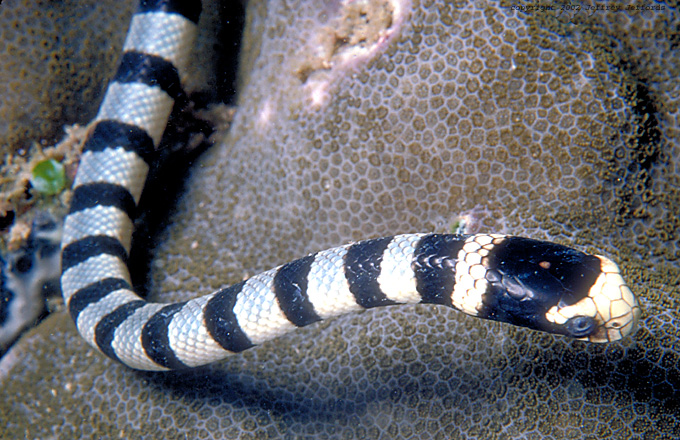One of the benefits of reading (& marking) students’ essays is that you find a whole pile of new papers that are worth reading. (I expect them to go to the scientific literature for information & examples, and support for their ideas, & I will confess to getting just a leetle tetchy when they don’t….) Why is this a benefit, you ask? Well, it’s just that there’s so much new material being published in scientific journals all the time – it’s next to impossible to keep up & this is one of the reasons that people tend to specialise. At least that way you can make a shot at keeping up to date in your own field! Most of the time I tend to see the same references, but now & then someone surprises me with something new & exciting. Like this paper…
 … on sympatric speciation in sea snakes. (Have a look at the title & try saying the last bit, very quickly, several times!)
… on sympatric speciation in sea snakes. (Have a look at the title & try saying the last bit, very quickly, several times!)
Sympatric speciation is reasonably common in plants, where the underlying mechanism is usually polyploidy. Polyploidy in animals is rare, and where sympatric speciation has been described in animals it’s usually based on ecological or behavioural isolation. Richard Shine & his colleagues investigated speciation in two closely-related species of sea snake, Laticauda colubrina & L. frontalis. They’re rather beautiful little animals – & also highly venomous. The authors comment that their study’s unusual because there’s been very little work done on the impact of breeding behaviour on sympatric speciation in reptiles.
The two species look almost identical, only colubrina can be much larger, and they’re found in the same geographic area. What’s more, their breeding seasons overlap. (They come ashore to breed on small Pacific islands – we were rapt to see them while we were in New Caledonia – & you can apparently find snakes of both species coiled together in hollows & under logs.) Yet they don’t interbreed. When the research team looked more closely at the snakes’ behaviour, they found that the species differed in how male courtship behaviour was triggered.
Now these cues can be quite variable. Some lizards (e.g Anolis species) use visual displays Pheromones seem to be important in other lizards, just as they are in many insects and mammals. Shine et al note that other researchers have found pheromones to be important in species identification in some snakes, but also comment that there have been no studies of the actual mechanisms by which sympatric snake species refrain from interbreeding.
The first step in their investigation was to observe male-female pairs of snakes in outdoor arenas, recording their behaviour & terminating each trial when the snakes began courting. The pairs were either conspecific (male & female of the same species) or heterospecific (different species). Male courtship behaviour includes frequent tongue-flicking, which suggests that there’s a pheromone involved as snakes use their tongue to ‘taste’. The male snakes showed a strong preference for females of their own species, and this preference was even more marked in L. frontalis, the dwarf species.
The second step was to obtain lipids from the snakes’ skins, because it’s known that some of these lipids act as pheromones. (They also waterproof the animals’ skins.) This was done by wiping the snakes’ bodies with cloth soaked in hexane, which acted as a solvent. The team found that females of the two snake species have quite different lipids on their skins, which they hypothesise are important species-recognition cues. Male snakes of both species were offered pieces of cloth soaked with frontalis lipids, colubrina lipids, & hexane alone (the control). And the results: male frontalis reacted most strongly to frontalis lipids, & colubrina males preferred colubrina lipids.
Shine & his co-workers concluded that was quite possible that these two sympatric species arose via sympatric speciation, and that the current separation beween the taxa is maintained by species-specificity in the cues that elicit courtship by males of both species, particularly the lipids produced in the females’ skin.
What an intriguing piece of work. And I probably wouldn’t have found it if some of my first-years hadn’t done some serious research for their essay topic. Thanks, guys!
R. Shine, R.R. Reed, S. Shetty, M. Lemaster & R.T. Mason (2002) Reproductive isolating mechanisms beween two sympatric sibling species of sea snakes. Evolution 56(8): 1655-1662
